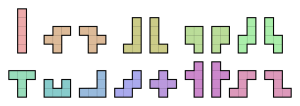“I’m proud that I’ve lived to see… so many of the things that I’ve worked on being so widely adopted that no one even thinks about where they came from.” ((Solomon W. Golomb – 2016 Laureate of the Franklin Institute in Electrical Engineering)) Solomon Golomb (1932-2016)
Solomon Golomb, who died on Sunday May 1st, was a man who revelled in the key objects in a recreational mathematician’s toolbox: number sequences, shapes and words (in many languages). He also carved out a distinguished career by, broadly speaking, transferring his detailed knowledge of the mathematics behind integer sequences to engineering problems in the nascent field of digital communications, and his discoveries are very much still in use today.
His mathematical interests started with prime numbers and number theory, completing his thesis “Problems in the Distribution of the Prime Numbers” in 1957. Shortly afterwards,
while working on matters of pure mathematics that supposedly had no practical application, specifically number theory and advanced algebra, he became interested in communications and cryptography. He began to think about how a curious mathematical phenomenon called a nonlinear shift register, or pseudorandom sequence, could be applied in those fields. ((Benjamin Franklin Medal write-up (2016) ))
Golomb worked
as a Senior Research Mathematician at Jet Propulsion Laboratory, later becoming Research Group Supervisor and then Assistant Chief of the Telecommunications Research Section, where he played a key role in formulating the design of deep-space communications for the subsequent lunar and planetary explorations. ((Solomon Golomb’s University of Southern California faculty page (archived) ))
In 1967, Sol Golomb wrote the book “Shift Register Sequences” about the predictable but seemingly random non-linear shift register sequences, which are
used in radar, space communications, cryptography and now cell phone communications. This book has long been a standard reading requirement for new recruits in many organizations, including the National Security Agency and a variety of companies that design anti-jam military communication systems. ((Introduction to Solomon W. Golomb (2002) ))
To see the breadth of Golomb’s interests, you only have to look at his publications list. His impact on recreational mathematics becomes obvious if you browse through a collection of Martin Gardner’s Mathematical Games columns – he has inspired at least four of these in full, with numerous smaller contributions. These include:
- Polyominoes
Solomon Golomb didn’t invent polyominoes ((In “Polyominoes“, Golomb attributes the observation that “there are twelve distinctive patterns (the pentominoes) that can be formed by five connected stones on a Go board… to an ancient master of that game”. Pentaminoes also appeared, for instance, in Dudeney’s “The Broken Chessboard” puzzle, published in the 1907 “Canterbury Puzzles“.)), but did coin the terms polyomino and pentomino (even holding the trademark on Pentominoes for some years) and created a whole subject area around them ((Golomb’s interest in polyominoes started as a student by generalising the mutilated chessboard problem.)), writing the defining 1965 book “Polyominoes” which was well-received and reached a broad audience: the 1975 Russian translation famously inspired Tetris. I recommend playing Golomb’s own game: players take turns placing one of the 12 pentominoes on a chessboard – the first player unable to make a move, loses. - Rep-tiles
Solomon gave a quarter-hour overview of rep-tiles at the 2014 Gathering for Gardner, which you can watch here. - Cheskers
A variation of chess played on only one colour of squares of the chessboard, as in draughts/checkers. - Golomb rulers
Again, studied for their applications and popularised, but not invented by Solomon, Golomb rulers were so named by Martin Gardner. Golomb also named Costas arrays, and coined a catchier name for a generalisation of Golomb rulers: graceful labellings (of graphs). Knowing Golomb’s passion for wordplay, many assumed that his co-author on several Golomb ruler papers, G. S. Bloom ((eg. Applications of numbered undirected graphs, G.S. Bloom and S.W. Golomb)), was merely an invented anagram of ‘S. Golomb’, when it was actually his student Gary’s name (as Sol fondly recalled in his 2014 Word-ways column “Anagramming Co-authors“).
Leafing through the Martin Gardner collection “Fractal Music, Hypercards and More”, for instance, reveals many more minor Golomb contributions in articles on “Tangent Circles” (with a couple of coin puzzles from Golomb’s article “Wreaths of Tangent Circles”), “Square Packing and Tiling” (can you tile the infinite plane with squares of side lengths 1, 2, 3, …?), and “Mathematical Chess Problems” (can you place n ‘superqueens’, which combine the movements of queens and knights, on an n by n chessboard so that none threaten each other?).
Given Sol Golomb’s interest in integer sequences, it seems appropriate to mention a couple of his. The self-describing Golomb’s sequence made it onto sequence connoisseur and OEIS founder Neil Sloane’s list of favourite sequences:
1, 2, 2, 3, 3, 4, 4, 4, 5, 5, 5, 6, 6, 6, 6, 7, 7, 7, 7, 8,… (A001462).
Solomon also investigated Hofstadter and Conway’s strange recursions, exploring simpler examples, and giving alternative starting conditions to one (the Fibonacci-ish $a_n := a_{n-a_{n-1}} + a_{n-a_{n-2}}$) to create a “quasi-periodic sequence of quasi-period 3”:
3, 2, 1, 3, 5, 4, 3, 8, 7, 3, 11, 10, 3, 12, … (A244477).
Beyond mathematics, Sol was interested in history, words and language (and could speak seven languages). His articles for the Word Ways recreational lingusitics journal show off his playfulness and knowledge on a range of topics: “A Letter to Martin” gives some obscure observations after a reading of Gardner’s “Annotated Alice”; alike-sounding ‘false-friends’ are explored in “Hebrew or Japanese?“; and “Extraterrestial Linguistics” draws together Golomb’s interests in language, space communications and mathematics.
Of course, nothing can give you a better sense of the man than listening to Sol himself talk about his life in an hour-long interview for the University of Southern California’s living history project, or watching a more mathematical and technical lecture he gave on his life’s work.
